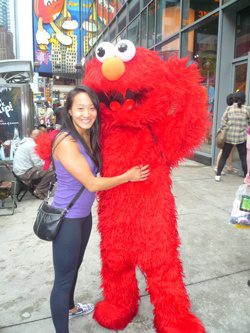It's an uphill battle.
You know what a client needs to do. Your clients probably know what they need to do. Yet, when they come into the gym their results don't meet expectations and, after a frank discussion, the reason is bad eating -- binging, alcohol, processed junk, and missed meals. They don't follow nutrition advice.
Your success hinges on your clients results and yes, it's your fault if they aren't following their eating plans. Either the plan you gave them was a bad one or you've coached it poorly.
Below are 3 strategies to get your clients to follow your personal training nutrition advice.
First, I'll lay out step-by-step instructions of the strategy. Then I'll tell a quick story of how it came about followed by the reasons why it's effective and when to use it.
Strategy #1 - Green Face
Steps to Green Face
Green Face n; A food that's either green (or a vegetable) and has or used to have a face (or a good protein source).
- Teach your client what green face is and tell them that it's your only diet recommendation. Tell them that apart from first thing in the morning and pre/post workout all foods should be green face.
- Every day when they walk into the gym look at them and say, "Have you been eating green face?" Soon this will turn into a simple, "Green face?"
How it came about
Honestly, I don't remember. I'd like to say that I'm smart enough to come up with something like this but that's probably not true. My guess is that I read about the concept in an article somewhere and thought that it would transition well into simple and effective food monitoring.
Why it's effective
Clients train with you two, maybe three times a week. The time is valuable and it needs to be used in the most efficient manner possible. With a simple, memorable term like green face, your client can communicate to you that they've adhered to their nutrition and you can move onto the workout. It's also a bit weird and will become "your thing" that you two share.
"Green face" is sticky. When a client goes into their fridge to get food they'll remember the words and immediately know whether the food choice they're making is a good one or bad. Heck, print out a smiley green face and give it to them. Here's a royalty free one.
 Obviously this is a simple and superficial guideline. It's not for advanced clients or high performing individuals. For most clients though this guideline is pretty darn good. As I always say (which I stole from some guy named Albert) "as simple as possible, but not any simpler."
Obviously this is a simple and superficial guideline. It's not for advanced clients or high performing individuals. For most clients though this guideline is pretty darn good. As I always say (which I stole from some guy named Albert) "as simple as possible, but not any simpler."
Use the green face with clients who have ten trillion things on their mind and can't possibly handle another job because their kids are in after school programs and husband also works a stressful job and tracking food more closely just won't happen.
Strategy #2 - Food Logs Done Right.
Steps to Food Logs Done Right
- Give your client three food logs (identical pages) and ask them to fill two out on different weekdays and the other on a weekend day.
- Sit across from your client with a desk in the middle. Spread all three pages out and ask, "What do you want to change?"
- Write down what they say and ask "anything else?" until satisfied (you should end up with 5-8 things).
- If nothing else is glaring, move on to step 6.
- Add on a habit that you'd like your client to change on the sheet.
- Say, "Great choices, I agree. Okay, so which do you want to tackle first?" *rustle page*
- If you agree with their decision, move to step 9.
- If you don't agree, say "good choice but I'd like to focus on something that will make the biggest difference right off of the bat. What are your thoughts on tackling this one?" *point to the one that you want to change*
- Say, "Awesome! Okay, so what's your strategy?"
- Devise a strategy for them to fix that one habit.
- When they've successfully fixed the first bad habit, sit them down and take out the paper with things to change. Put it on the table in between you and cross out the bad habit while saying, "What next?"
How it came about
I studied Kinesiology at the University of Western Ontario where I was fortunate to gain a mentor in Dr. Peter Lemon (also the mentor of Dr. John Berardi). It was here that I learned how to use food logs properly.
While training clients, the food logs were usually filled out properly but adherence to the resulting plan was abysmally low. Stemming from the work on self-efficacy by Dr. Albert Bandura, I decided to devise a plan to give my clients ownership over their own decisions.
Why it's effective
Three-day food logs work. It's impossible to establish a great eating plan if you don't know your clients existing eating habits. Once you know what your clients are eating you probably have an idea of what you would like them to change by focusing on the most important things first.
There are also a couple constants, like adding a multi-vitamin and fish oil that almost every client would get an immediate measurable benefit from doing.
For the most part clients know what needs to be fixed. People aren't stupid. They know that two cans of Coke a day is what's making them fat or that binge eating on pizza at night after a stressful day of work is curbing their results.
Allowing them to take ownership over the decision and choosing what modification they want to make next is a powerful buy-in on their part. It's their decision. They're invested in sticking to it. The best coaches know what questions to ask and help devise an effective strategy based off the answers. The worst coaches preach without adequate information based on their own experiences and biases.
Use this strategy for all new clients or for clients where you think that adherence to their nutrition plan is low.
Note: I don't recommend speaking to clients about alcohol intake at night (which was been a huge issue with a lot of my clients). My opinion is this:
Alcohol at night is usually a compensatory behavior for somebody who's stressed out or needs to separate from his or her anxieties. Everybody knows it's unhealthy. You don't need to say anything. Once they follow all the other habits along with your exercise plan they'll start to feel better and will stop drinking on their own. It's empowering for them.
Strategy #3 - The Tattered Napkin
Steps to the Tattered Napkin
- Rip off a piece of paper from a sheet on your clipboard (the better a spectacle you make of this the more points you get -- imaginative points -- very important).
- Write down as succinctly as possible instructions to your client to fix the behavior that they need a nudge in solving.
- Sign the paper, scrunch it up, and tell your client to put it in his or her pocket.
- Instruct them to have that nasty, stinky, moldy, tattered piece of paper in his or her pocket every time that your client will be in a situation that the bad habit could occur.
How it came about
Please keep in mind that this is an entirely hypothetical story... entirely.
 You know when you're at a bar and you meet a beautiful girl with legs that scream, "I squat."
You know when you're at a bar and you meet a beautiful girl with legs that scream, "I squat."
You're nervous at first because she has beautiful eyes and is more of a natural beauty -- who squats. Then you see her looking at you and you look back quickly at first playing it cool -- well not cool, dorky actually -- but thinking that you're playing it cool.
Then this hypothetical girl goes to the bar. So you go to the bar even though your drink is three-quarters full.
She smiles at you and you start a dorky conversation asking about the ring that she's wearing. Yadda yadda yadda she writes down her number on a tattered napkin and you put it in your pocket before she leaves with her friends.
Then for the rest of the night you don't ever need to look at the napkin again because you know what's there but you put your hand in your pocket anyway and smile because it reminds you of the pretty girl.
This not-so-hypothetical story is how the "tattered napkin" came about. It, uhh, happened to a friend of a friend of mine.
Why it's effective
Our minds work on associative connections. The sheer volume of information that they take in is impossible to process. It connects actions with events that have happened in the past to come to conclusions. Our mind takes shortcuts.
Making the change that your client is paying you to help him or her make is emotional but there will be periods where they're prone to relapse. Feeling the tattered napkin in his or her pocket will start a cascade of actions that happen in a fraction of a second to remind your client of why they are working to make this change. That cascade of events stops them from making the bad choice.
Use this system for clients who have one place or one situation where they're prone to falling off that plan.
Here's an example:
I had a client who would eat great if she had good food in the house but always shopped for junk. I tore off a piece of the program sheet and wrote, "Buy Veggies -- Not junk!" and signed it. That client kept that grungy piece of paper in her pocket for two years every time she went grocery shopping.
At 67 years of age with two knees that were supposed to be operated on she lost 53 pounds and was told her knees are now fine.
This is a scan of that nasty piece of paper:












